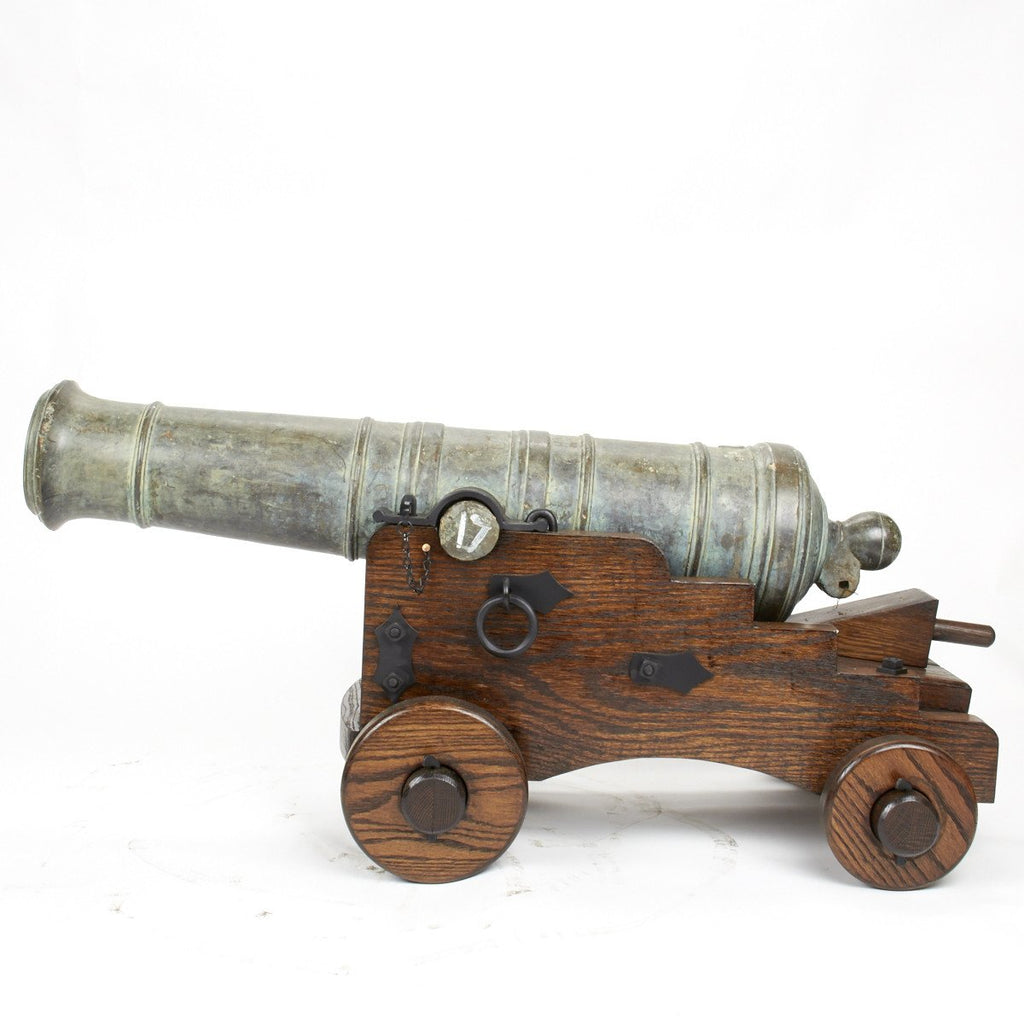Item Description
Original Item: One-of-a-kind. Here is a splendid Bronze cannon tube with a wonderful patina, just like a Church roof! This cannon barrel has the classic lines of those used on the 18th Century Galleons and Pirate Ships.
Bore size of 3 5/8" making this a SIX POUNDER, commonly called a "Saker" in the 18th century. The barrel is 45 inches in overall length, and 10 ¼ inches in diameter at it widest point at the rear. The flared muzzle is 8 ¼ inches in diameter.
The tube itself has many reinforcing bands cast into the design; each has with its own name. Beginning with the base ring, the widest point at the rear end, followed by the base ring ogee, first reinforce ring and ogee, muzzle astragal and fillets, right up to the widening muzzle known as the muzzle swell.
The design leads us to believe that this cannon dates from approximately 1770-1790 and almost certainly produced by at a European foundry. Discovered by IMA in 2003 at the former British garrison in Kathmandu, Nepal where it has lain for at least the last 200 years no markings remain, most likely those of the British East India Company, if any, were present.
The all oak naval carriage on which this barrel is displayed has been custom manufactured to our precise specifications. It is a nearly exact copy of a British Naval Man-o-War wood carriage from the last half of the 18th Century. The carriage measures 33 inches long and 24 inches at it's widest point. It is expertly constructed of 2-inch wide Oak with hand-forged iron cap squares and mounts, just how they were made 250 years ago. It is even sturdy enough to be fired from. The carriage is correctly fitted with the early style shoe elevation system using an angled ramp pushed in from the rear to gain the correct firing elevation when in use. Cannon tube on carriage is just 48 inches long and 24 inches wide making this and easy to display for a cannon of this magnitude.
IMA commissioned the construction of this carriage especially for this barrel making a most attractive original Bronze Cannon tube into a stunning historically accurate display piece for home or office. In fact, we will include a small booklet of photographs showing the carriage under construction supporting the fact that this has been tailor made using the construction methods of 250 years ago, as well as our book Treasure is Where You Find It with photos of this very cannon tube’s discovery in Kathmandu Nepal.
Truck freight curbside delivery ex New Jersey warehouse. Typical freight cost is $500 east of Mississippi and $750 to points west. Please contact us for an exact quote.
History of the Saker-
The saker was a medium cannon slightly smaller than a culverin developed during the early 16th century and often used by the English. It was named after the Saker Falcon, a large falconry bird native to the Middle East.
A early saker's barrel was approximately 9.5 ft (2.9m) long, had a calibre of 3.25 inches (8.26 cm) and weighed approximately 1900 lb (860 kg). It could fire round shot weighing 5.25 lb (2.4 kg) approximately 7400 ft (2.3 km) using 4 lb (1.8 kg) of black powder. The shot (designed well before explosive artillery had been devised) was intended to bounce along the ground to cause as much damage as possible. Tests performed in France during the 1950s show a saker's range was over 9000 ft (2.7 km) when fired at a 45-degree angle.
Henry VIII amassed a large arsenal of sakers in the early 16th century as he expanded the Royal Navy and came into conflict with France. Henry's foundries used so much bronze that there was a world shortage of tin. According to the inventory in the Anthony Roll the Mary Rose carried several sakers, though none have been found so far and may have been recovered by salvagers soon after the disaster. Sakers were heavily used during the English Civil War, especially during sieges when they were used by both attackers and defenders of fortified towns. They also saw action in the Jacobite rising and were used by the armies of both William III and James II at the Battle of the Boyne.
A French version of the saker, the moyenne, meaning "middle sized", was often used at sea.[3] Venetian merchant ships often carried sakers to defend themselves from pirates, and similar cannons have been found on Spanish Armada wrecks.
In the New World the colonists removed the naval guns from their ships for use in land engagements, often installed in the forts they built to protect their newly founded towns from French, Spanish and hostile Indians.
- This product is available for international shipping.
- Considered an ANTIQUE by the U.S. Bureau of Alcohol, Tobacco, Firearms and Explosives, meaning no Federal restrictions for ownership, transport, trade or possession, it is totally legal to own without any form of license.
- Not eligible for payment with Paypal or Amazon

































